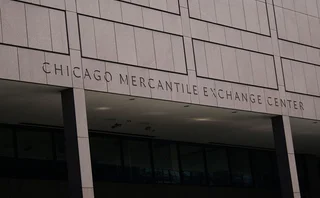
LCH.Clearnet considers revaluing $212 trillion swap portfolio
LCH.Clearnet could start using overnight indexed swap (OIS) rate curves rather than Libor to value its roughly $212 trillion swap portfolio, in response to changing market practice.

The London-based clearing house is weighing up a change in the way it calculates the present value of its cleared interest rate swap portfolios that would bring it into line with new market practice - dealers increasingly use OIS rather than Libor curves for pricing and valuation of collateralised trades (Risk March 2010, pages 19-22). However, the clearer has stopped short of committing to OIS discounting, pending the results of in-depth analysis and approval from its risk committee.
"Within the next few months, we should have a clear path we're going to take one way or another. We need to make sure we're proposing the right thing. We are finishing the analysis and consultation process around this, but at this stage, the indication is we need to do something," says Daniel Maguire, director and head of over-the-counter interest rate and foreign exchange derivatives, risk and operations at LCH.Clearnet in London.
The move from LCH.Clearnet comes after major market participants reviewed their own pricing methodologies. Before the financial crisis, all market participants (including LCH.Clearnet) priced interest rate swaps by discounting future cashflows at Libor. However, as banks' borrowing rates ballooned with the onset of the credit crisis, some dealers identified OIS as the appropriate rate at which to discount collateralised swaps.
At inception, most swaps tend to be at-the-market and the present value is zero. As the market moves, a collateralised trade will produce daily collateral calls based on the revised value of the swap. If a party owes money under its swap contract, it must post an equivalent amount of collateral to its counterparty.
Collateral agreements require interest on collateral to be paid at a relevant OIS rate. Consequently, future cashflows in collateralised trades should be discounted at the same rate: the party that is owed money at the end of the swap will have been paying an OIS rate on the collateral it has been holding, so the ultimate value of the cash it will receive will be the sum it is owed minus the OIS rate it has paid on this collateral.
Maguire says LCH.Clearnet first became aware of the issue when reviewing data from the Lehman Brothers default. When a member of SwapClear - LCH.Clearnet's interest rate swaps clearing service - defaults, the central counterparty neutralises the swap portfolios by putting on hedges. It then asks the non-defaulting members of SwapClear to give a net present value bid for the portfolios. The clearer subsequently passes the portfolio on to the successful bidder. However, when LCH.Clearnet received bids, there were some discrepancies in price.
"We saw anomalies around some of the bids that suggested our valuations were not at-market. Not hugely, but enough to investigate. While the impact on the Lehman portfolio was not material, it became apparent some members were bidding on mid-market Libor, whereas some were bidding on mid-market OIS," says Maguire.
This prompted the clearer to take a closer look. In early 2009, LCH.Clearnet began a consultation process with 18 member firms. As things stand, the clearer's default management process obliges SwapClear members to bid on auction portfolios in default. LCH.Clearnet values and charges variation margin on a daily basis, and collateral calls are made in cash. LCH.Clearnet pays OIS on that cash collateral. In this context, LCH.Clearnet asked SwapClear members how they would bid on a cleared portfolio of swaps from the interdealer market, and how they would price the portfolio.
"There was clear consensus from the members that the right approach, given LCH.Clearnet's position, was to value off OIS, and most said they would bid at mid-market on an OIS basis. The remainder provided no indication either way. We have to recognise the market's view on this and make sure our valuation methodologies are present and current so as to protect the financial integrity of LCH.Clearnet," says Maguire.
Changing to an OIS discount curve is challenging. OIS curves of minor currencies can be illiquid, as can major currency curves going out further than two years. Whether to factor OIS discounting into initial margin requirements is another possible bone of contention. However, Maguire believes most of its swaps risk can be revalued with ease.
"We can probably cover the majority of the risk easily and quickly, although it's a slightly more cursory approach than if we were trading on a profit-and-loss basis. Our major risk is in three to five currencies, all of which are liquid OIS markets," he says. "There is a potential ripple effect for actions LCH.Clearnet takes. But it is of paramount importance LCH.Clearnet protects itself adequately for the event of a default, and ensures the bid we get is close to our daily valuation method. In the case of the valuation being incorrect, initial margin is eroded quickly and we get through our layers of default protection more quickly."
LCH.Clearnet is now analysing how it would change its systems to value off OIS curves, including the economic impact this would have. Maguire says he would then like to present proposals to the industry for feedback, before taking the project to LCH.Clearnet's risk committee for approval.
Click on the link below for another recent story on LCH.Clearnet.
Only users who have a paid subscription or are part of a corporate subscription are able to print or copy content.
To access these options, along with all other subscription benefits, please contact info@risk.net or view our subscription options here: http://subscriptions.risk.net/subscribe
You are currently unable to print this content. Please contact info@risk.net to find out more.
You are currently unable to copy this content. Please contact info@risk.net to find out more.
Copyright Infopro Digital Limited. All rights reserved.
As outlined in our terms and conditions, https://www.infopro-digital.com/terms-and-conditions/subscriptions/ (point 2.4), printing is limited to a single copy.
If you would like to purchase additional rights please email info@risk.net
Copyright Infopro Digital Limited. All rights reserved.
You may share this content using our article tools. As outlined in our terms and conditions, https://www.infopro-digital.com/terms-and-conditions/subscriptions/ (clause 2.4), an Authorised User may only make one copy of the materials for their own personal use. You must also comply with the restrictions in clause 2.5.
If you would like to purchase additional rights please email info@risk.net
More on Interest rate markets
New benchmark to give Philippine peso swaps a fillip, post-Isda add
Isda to include new PHP overnight rate and Indonesia’s Indonia in its next definitions update
SABR convexity adjustment for an arithmetic average RFR swap
A model-independent convexity adjustment for interest rate swaps is introduced
NatWest Securities US Treasury trading head departs
Jason Sable joined the UK bank in January 2022 from BNP Paribas
CME in talks to clear term SOFR basis swaps
US clearing house has held discussions with some dealers about clearing term SOFR-SOFR packages
Risky caplet pricing with backward-looking rates
The Hull-White model for short rates is extended to include compounded rates and credit risk
The curious case of backward short rates
A discretisation approach for both backward- and forward-looking interest rate derivatives is proposed
Cross-currency swaps will use RFRs on both legs, says JP exec
Despite slow start, all-RFR swaps will become the market standard within a year, according to Tom Prickett
June mid-month auctions – Coupon and yield trends
As Treasury issuance amounts set new records, coupons at the front end of the curve have marched downward, while back-end coupons have lagged. Yield spreads across each popular measure show a consistent steepening of the curve through the first half of…







